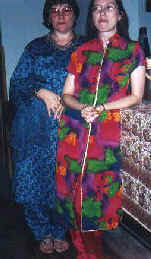|
the Indian Party |
|
| Clothing & Dress |
|
the Indian Party |
|
| Clothing & Dress |
|
|
Indian clothing is bright, comfortable
and flattering to most body types. We had fun trying different looks and
color combinations (many of which look very foreign to Western eyes).
Probably the most familiar garment is the sari. There are literally dozens of different draping styles (including the dhoti sari now worn almost exclusively by men), many specific to a region or family group. Not a rigid garment form but rather a single piece of cloth draped, pleated, wrapped and tucked to form a shape that is seen throughout the country regardless of age or social level. A choli top and petticoat is usually worn underneath the sari but historically examples show it worn alone. None of our group was that daring! |
|
Men's clothing, generally less bright, can be as simple as loose, drawstring trousers (salwar) worn with a long collarless shirt ( a kurta) or a dhoti. The businessman's three-piece-suit consists of salwar, a kurta, and a jacket, all nicely coordinated. The sleeveless, collarless jacket resembles a vest.
|
|
 |
Another very common women's outfit is
the salwar kamiz set. This consists of a long, loose tunic and salwar. A
long drape, often a yard wide with a fringed or printed border, is worn
around the shoulders or over the head. The three pieces don't always
match and can be made of anything from simple, embroidered cotton to
inticately beaded silk.
Genie & Sue in salwar kamiz . |
|
There are also many styles of "peasant" dress identifiable as Indian by the bright colors and embroidery. Accessories would include sandals, shoes (or barefoot), bindi, turbans, tons of jewelry (much noisy), and flowers in your hair; always combining as many colors as you like
Nora in peasant dress |
|
| Back to Main |  |